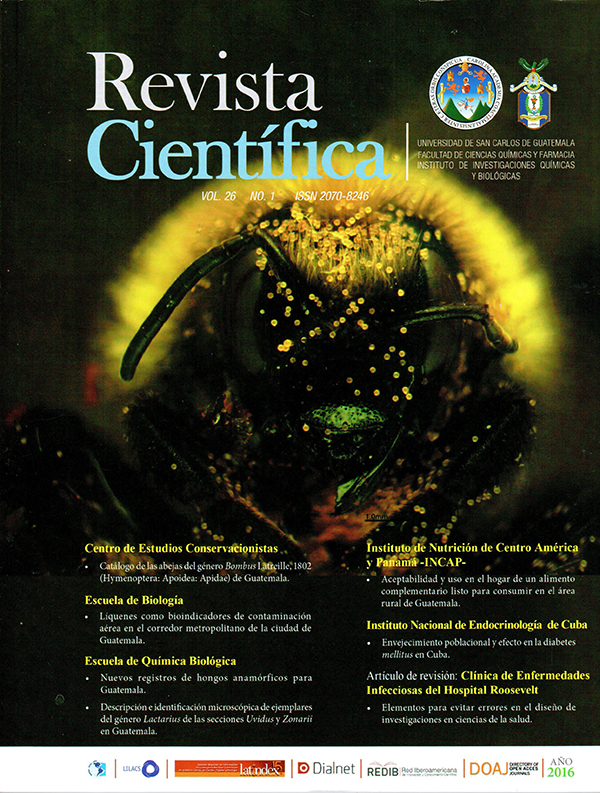New records of anamorph fungi from Guatemala
DOI:
https://doi.org/10.54495/Rev.Cientifica.v26i1.80Keywords:
Ecological reserve, conidial fungiAbstract
Anamorphic fungi are a diverse group of microscopic fungi that reproduce asexually through conidia. They degrade plant debris on the soil, which is a key process in nutrients recycling. Because of its importance and the lack of information regarding to these fungi in Guatemala, In this article, 12 species were identified through microscopic characteristics, after extraction of fungal structures developed in leaves, twigs and seeds collected at the Cayalá Ecological Reserve in Guatemala City. Reference materials are placed at the anamorphic fungi collection at Micoteca de Macro hongos de Guatemala, “Dr. Ruben Mayorga Peralta” (MICG).
Downloads
References
Baker, W., Partridge, E., & Morgan-Jones, G. (2002). Notes on Hyphomycetes. LXXXV. Junewangia, a genus in which to classify four Acrodictys species and a new taxon. Mycotaxon, 81, 293-319.
Castañeda, R., & Kendrick, B. (1991). Ninety-nine conidial fungi from Cuba and three from Canada. University of Waterloo Biology Series, 35, 1-132.
Castañeda–Ruiz, R.F. (2005). Metodología en el estudio de los hongos anamorfos. En: Anais do V Congresso Latino Americano de Micología.(pp. 182-183). Brasilia.
Castañeda, R., Heredia, G., Arias, R., Saikawa, M., Minter, D., & Stadler, M. (2007). Anamorphic fungi from submerged plant material: Phaeomonilia pleiomorpha, P. corticola and Cacumisporium pleuroconidiophorum. Mycotaxon, 100, 327-336.
Ellis, M. (1976). Dematiaceous hyphomycetes. Surrey: Commonwealth Mycological Institute. https://doi.org/10.1079/9780851983653.0000
Heredia, G., Castañeda-Ruiz, R.F., Becerra C., & Arias, R. (2006). Contribución al conocimiento de los hongos anamorfos saprobios del Estado de Tabasco. Revista Mexicana de Micología, 23, 53-62.
Heredia, G., Reyes, M., Arias, R., Mena–Portales, J., & Mercado, A. (2004). Adiciones al conocimiento de la diversidad de los hongos conidiales del bosque mesófilo de montaña del Estado de Veracruz. Acta Botánica Mexicana, 66, 1-22. https://doi.org/10.21829/abm66.2004.969
Karandikar, K., & Patwardhan, P. (1986). Two new generic reports to fungi of India. Current Science, 55(4), 197-198.
Matsushima, T. (1971). Microfungi of the Solomon Islands and Papua-New Guinea. Osaka: Nippon Printing Publishing.
Nawawi, A., Kuthubutheen, A., & Sutton, B. (1990). New species and combinations in Vermiculariopsiella (Hyphomycetes). Mycotaxon, 37, 173–182.
Olivera, M., Pascholati, L., & Costa, L. (2008). Espécies de Vermiculariopsiella (Hyphomycetes) associadas a substratos vegetais em fragmento de Mata Atlântica, Serra da Jibóia, Estado da Bahia, Brasil. Revista Brasileira de Botânica, 31(4), 659-665. https://doi.org/10.1590/S0100-84042008000400011
Paulus, B., Gadek, P., & Hyde, K. (2004). Phylogenetic and morphological assessment of five new species of Thozetella from an Australian rainforest. Mycologia, 96(5), 1074–1087. https://doi.org/10.2307/3762090
Pirozynski, K. (1963). Beltrania and related genera. Mycological Papers, 90, 7-11.
Quiñónez, J. (2006). Estudio sobre la riqueza y la abundancia de especies de aves en dos áreas de bosque con diferente grado de perturbación antropogénica (Tesis de Licenciatura). Universidad de San Carlos de Guatemala, Facultad de Ciencias Químicas y Farmacia, Guatemala.
Rifai, M. (2008). Another note on Podoconis megasperma Boedijn (Hyphomycetes). Reinwardtia, 12(4), 277-279.
Samson, R. (1974). Paecilomyces and some allied hyphomycetes. Studies in Mycology, 6, 1-119.
Seifert, K., Morgan-Jones, G., Gams, W., & Kendrick, B. (2011). The genera of Hyphomycetes. Hong Kong: APS Press.
Ulloa, M., & Hanlin, R. (1978). Atlas de micología básica. México, D.F.: Concepto, S.A.
Downloads
Published
How to Cite
Issue
Section
License
Copyright (c) 2016 Ricardo Figueroa, María del Carmen Bran, Osberth Morales, Rafael Castañeda-Ruiz

This work is licensed under a Creative Commons Attribution 4.0 International License.
Authors who publish with this journal agree to the following terms:
- Authors retain copyright and grant the journal right of first publication with the work simultaneously licensed under a Creative Commons Attribution License 4.0 that allows others to share the work with an acknowledgement of the work's authorship and initial publication in this journal.
- Authors are able to enter into separate, additional contractual arrangements for the non-exclusive distribution of the journal's published version of the work (e.g., post it to an institutional repository or publish it in a book), with an acknowledgement of its initial publication in this journal.
- Authors are permitted and encouraged to post their work online (e.g., in institutional repositories or on their website) prior to and during the submission process, as it can lead to productive exchanges, as well as earlier and greater citation of published work.









